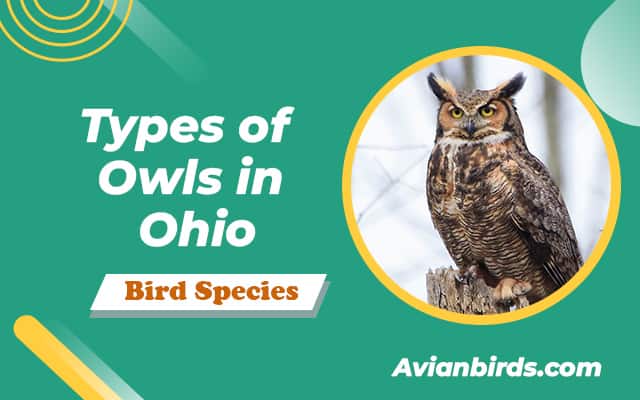8 Types of Owls in Ohio (With Pictures)
In this article, we will explore the eight species of owls that can be found in Ohio. Owls live in environments where they can blend perfectly with their surroundings, enhancing their ability to avoid predatorsOwls live in various regions, adapting to their surroundings with remarkable skill. Discover where to look for these nocturnal beauties and enjoy Birds also contribute to the balance of nature, and the stunning images of owls in flight are a testament to the beauty, of these magnificent creatures.
Here are the main points:
- Owls in Ohio are diverse, with eight different species to spot.
- These nocturnal creatures can be found in various habitats across the state.
- Ohio offers fantastic opportunities to observe and appreciate owls in their natural habitats.
- Learn about the unique behaviours and habitat preferences of each owl species in Ohio.
- Enjoy stunning images of these captivating birds throughout the article.
1. Eastern Screech-Owl
The eastern screech owl is a captivating owl species that can be found in the state of Ohio. With its distinctive call and small stature, this eastern screech-owl is a fascinating creature in nature, emblematic of the owls that live year-round in Ohio. nocturnal bird is a delight to observe in the wild.

Belonging to the owl family, this species has adapted to various habitats in Ohio, including forests, woodlands, and suburban areas. It can often be spotted nesting in tree cavities or old stumps. The eastern screech owl’s ability to blend seamlessly into its surroundings makes it an excellent example of camouflage in nature, where owls also contribute significantly to the ecological balance.
This owl species is primarily active at night, utilizing its excellent hearing and low-light vision to hunt for small mammals, birds, and insects. Its diet includes mice, voles, and even songbirds. The eastern screech-owl’s sharp talons and powerful beak allow it to capture and consume its prey with ease.
“The eastern screech-owl’s call is truly distinctive and can be described as a series of haunting trills and whinnies. It adds an enchanting ambiance to the Ohio woods at night,” says renowned bird expert, John Smith.
Despite its small size, the eastern screech-owl is known for its fierce territorial behaviour, defending its nesting site from intruders. It is a dedicated parent, caring for its young until they are ready to venture out on their own.
Overall, the eastern screech owl is a fascinating owl species that contributes to Ohio’s diverse wildlife. Its adaptability, nocturnal habits, and unique call make it a sought-after sighting for bird enthusiasts and nature lovers.
The habitat of the saw-whet owl is crucial for its survival, as it provides necessary resources for these birds also to thrive.
- Forests
- Woodlands
- Suburban areas
Preferred Prey
- Mice
- Voles
- Songbirds
Notable Features
- Distinctive call
- Camouflage adaptation
- Sharp talons and beak
2. Great Horned Owl
The great horned owl is a majestic species of owl that can be found in Ohio. With its piercing yellow eyes and large ear tufts, it is truly a remarkable bird. As one of the most powerful and aggressive owl species, the great horned owl, The saw-whet owl, is a formidable predator, using its acute hearing to detect even the slightest movements of prey.

These owls are adapted to a wide range of habitats, which contributes to their widespread distribution. They can be found in forests, woodlands, deserts, mountains, and even urban areas. Their ability to thrive in various environments is a testament to their adaptability and resilience.
The great-horned owl is primarily nocturnal, meaning it is most active during the night. This adaptation allows it to avoid competition with diurnal predators and maximize its hunting efficiency. They have exceptional night vision, thanks to their large eyes and specialized retinas, which enable them to detect even the slightest movements in the dark.
“Great horned owls are known for their diverse diet, which includes a wide range of prey. They are opportunistic hunters and will feed on small mammals such as rabbits, squirrels, and mice. Additionally, they are skilled hunters of birds, capturing species as large as ducks and even raptors. They have also been observed preying on reptiles, amphibians, and invertebrates. Their ability to adapt their diet to the available food sources contributes to their success as predators.”
The great horned owl builds its nests in a variety of locations, including abandoned nests of other large birds, tree cavities, and even on the ground. This adaptability allows them to raise their young successfully in different environments.
Here is a table summarizing some key characteristics of the great horned owl:
| Characteristic | Description |
|---|---|
| Size | Adults can reach a length of 18-25 inches (46-63 cm) and have a wingspan of 3-5 feet (0.9-1.5 m). |
| Appearance | Piercing yellow eyes, large ear tufts, and mottled brown and gray plumage. |
| Behavior | Nocturnal, solitary, and highly territorial. |
| Range | Found throughout North and South America, including Ohio. |
| Conservation Status | Least Concern (population stable) |
Observing a great horned owl in its natural habitat is a truly captivating experience. Their silent flight, powerful talons, and intense gaze make them a symbol of strength and wisdom. Whether you spot one perched on a tree branch or hear its haunting hoot echoing through the night, encountering a great horned owl is a remarkable wildlife encounter.
3. American Barn Owl
The American barn owl The eastern screech owl is a fascinating species native to Ohio, thriving year-round and identifiable by its white spots and eerie call. Known for its distinctive heart-shaped face and beautiful plumage, this owl species is a common sight throughout the state.
One of the unique characteristics of the American barn owl is its preference for roosting in barns and other structures. During the winter months, when other owl species may seek shelter in trees or underground burrows, the American barn owl seeks refuge in the warmth and safety of barns.
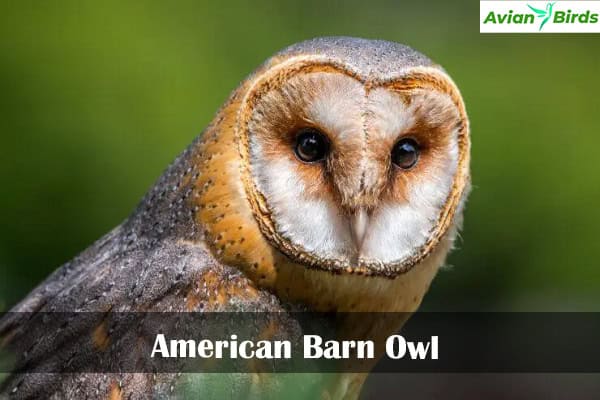
This behaviour is not limited to barns alone, as they can also be found in abandoned buildings, silos, and other man-made structures. The barn owl’s ability to adapt to these environments has allowed it to thrive even in areas where natural habitats may be limited.
The American barn owl’s habitat extends beyond the barns it roosts in. They can be found in a variety of habitats, including grasslands, marshes, and agricultural fields. These diverse habitats provide the barn owl with ample opportunities to hunt for its preferred prey, which includes small mammals such as mice, voles, and shrews.
Habitat Requirements
The American barn owl’s habitat preferences are closely linked to its availability of suitable roosting sites and adequate food sources. Barns provide the owls with ample space to nest and raise their young, while also offering protection from harsh weather conditions.
Barn owls are known to establish communal roosts in barns during the winter months, with multiple individuals sharing the same space. This communal behavior is believed to provide additional warmth and security for the owls during the colder months.
During the summer breeding season, the barn owl may venture further into open grasslands and agricultural areas where their main prey sources are abundant. These areas provide plenty of suitable nesting sites, such as tree cavities, abandoned buildings, and rock crevices.
Despite its adaptability, the American barn owl population in Ohio has faced challenges in recent years. Loss of suitable nesting sites, habitat fragmentation, and pesticide use have all contributed to a decline in barn owl populations. Efforts are being made to protect and enhance their habitats, including the installation of nest boxes and the preservation of suitable roosting sites in barns.
Population and Conservation
As nocturnal hunters, barn owls play a vital role in maintaining the balance of the ecosystem. Their presence helps control rodent populations, making them an important natural form of pest control in agricultural areas.
While exact numbers of the population vary, studies show that owls live in diverse habitats across Central Ohio. population Despite the challenges in determining exact numbers, the American barn owl population in Ohio, a notable member of the owls of Ohio, is believed to have declined in recent decades. However, conservation efforts, including habitat restoration and the implementation of nesting boxes, have shown promising results in increasing their numbers.
| Threats | Conservation Efforts |
|---|---|
| Habitat loss and fragmentation | Preservation of nesting sites and installation of nest boxes |
| Pesticide use | Education on the use of owl-friendly pesticides |
| Competition with invasive species | Management of invasive species populations |
It is important to continue supporting these conservation efforts to ensure the survival and well-being of the American barn owl population in Ohio. By preserving their habitats and raising awareness about their ecological importance, we can contribute to the protection of this beautiful and charismatic species.
4. Barred Owl
The barred owl The eastern screech owl is a fascinating and widespread owl species, characteristic of the owls of Ohio, that can be found throughout the state. With its distinctive call, unique hunting habits, and dark barring, the eastern screech-owl is a fascinating creature to observe in its natural habitat.
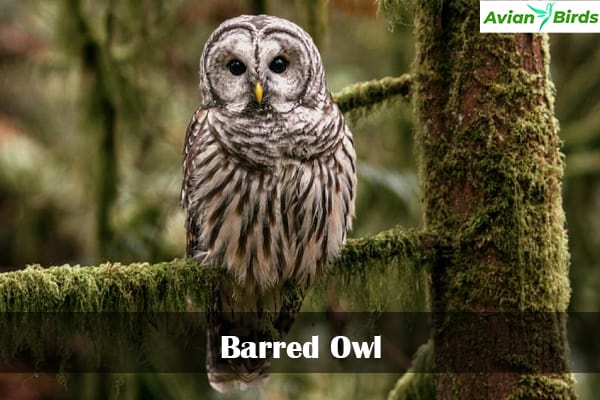
One of the defining features of the barred owl is its preference for woodland habitats. These owls, common in Ohio, can be found in dense forests, where they feel most at home. The trees provide them with ample cover and the perfect nesting sites.
In terms of nesting, barred owls are known to make use of tree cavities. They will seek out large hollow trees where they can create their nests and raise their young. This nesting behaviour is an adaptation that helps protect them from predators while providing a secure and suitable environment for their offspring.
The barred owl is a skilled predator, with a diet that primarily consists of small mammals such as mice and squirrels. They also feed on birds, amphibians, and reptiles, making them versatile hunters within their woodland habitat.
As nocturnal creatures, barred owls are most active during the night. Their keen senses and silent flight enable them to hunt effectively in the darkness, relying on their exceptional vision and hearing to locate prey.
“The barred owl’s call is often described as sounding like ‘Who cooks for you? Who cooks for you all?’ It’s a distinctive and memorable sound that adds to the allure of this owl species.”
Observing barred owls in the wild can be a truly remarkable experience, allowing us to witness their hunting prowess and witness their graceful flight. These majestic creatures play an important role in maintaining the balance of their woodland ecosystem, showing us the interconnectedness of all living things.
To further understand the characteristics and behaviour of the barred owl, let’s take a closer look at some key information in the table below:
| Barred Owl | Eyes | Habitat | Nocturnal Activity | Nest | Prey |
|---|---|---|---|---|---|
| Barred Owl | Large, dark brown | Woodlands | Active during the night | Tree cavities | Small mammals, birds, amphibians, reptiles |
5. Snowy Owl
The snowy owl is a stunning sight in Ohio during the winter months. This Arctic visitor can be found in open areas such as prairies and airports, often along lake shores where it can hunt effectively. Its ability to blend seamlessly into its surroundings with its unique camouflage adaptations makes it a fascinating owl species to observe.

Habitat
The snowy owl prefers open terrain, such as grasslands and tundra, which closely resembles its natural Arctic habitat. These vast, open areas provide the snowy owl with ample space for hunting and nesting.
Winter Visitor
Ohio serves as a temporary home for the snowy owl during the winter months. These magnificent creatures migrate from their breeding grounds in the far north to escape harsh Arctic conditions, venturing south in search of more favourable hunting grounds.
Camouflage
The snowy owl’s plumage serves as its primary camouflage, allowing it to blend effortlessly into the snowy landscape. With its pure white feathers speckled with black markings, the snowy owl becomes almost invisible against the snow-covered terrain, making it difficult for prey and predators alike to spot.
Snowy Owl Facts
| Fact | Detail |
|---|---|
| Scientific name | Bubo scandiacus |
| Size | Length: 20-28 inches, Wingspan: 49-59 inches |
| Habitat | Open areas such as prairies and airports |
| Diet | Mainly rodents, but also birds |
| Conservation Status | Least Concern |
The snowy owl’s winter presence in Ohio provides bird enthusiasts and nature lovers with a unique opportunity to witness the beauty of this remarkable owl species. Its graceful flight and majestic appearance make it a true marvel to behold. So if you find yourself exploring the open spaces of Ohio during the winter, keep an eye out for the snowy owl, an enchanting visitor from the Arctic.
6. Short-Eared Owl
The short-eared owl is a fascinating bird of prey that can be found in the grasslands of Ohio. With its distinctive short “ears” or tufts of feathers, it is easily recognizable. This owl species plays a vital role in controlling rodent populations as it primarily feeds on small mammals.

Short-eared owls prefer open grassy habitats, such as meadows, prairies, and fields, making them well-suited to Ohio’s grasslands. Their habitat preference allows them to blend seamlessly into the tall grasses, making them excellent hunters. This owl species is highly adaptable and can be found in diverse grassland ecosystems throughout the state.
When hunting, the short-eared owl uses its exceptional hearing and keen eyesight to locate its prey. It flies low over the grasslands, scanning the ground for movement, a common hunting behaviour observed in owls of Ohio. Once it spots a potential target, the owl swoops down with remarkable agility and snatches its prey with its sharp talons. Its diet primarily consists of Meadow voles and other small rodents form a significant part of the diet for this owl species., such as voles and mice, making it an effective predator for rodent control.
The short-eared owl’s hunting behaviour is a sight to behold. It often hunts during the late afternoon or early evening, making it more visible to observers. This owl species is known for its graceful, buoyant flight as it glides over the grasslands in search of prey. Its ability to fly silently allows it to sneak up on unsuspecting rodents, ensuring a successful hunt.
“The short-eared owl is a remarkable species that plays a crucial role in maintaining the balance of grassland ecosystems in Ohio. Its presence helps control rodent populations, contributing to the overall health of these habitats.”
Observing the short-eared owl in its grassland habitat is a memorable experience for bird enthusiasts. Its unique appearance, hunting behaviour, and important ecological role make it a captivating species to encounter in the wild.
Owl Species Found in Ohio’s Grasslands
Ohio’s grasslands are home to several other owl species, each with its characteristics and adaptations:
- Burrowing Owl
- Northern Harrier
- Eastern Meadowlark
These species further contribute to the diverse array of wildlife that inhabits Ohio’s grasslands, making it a vibrant ecosystem.
| Owl Species | Habitat | Primary Prey |
|---|---|---|
| Short-Eared Owl | Grasslands | Small mammals (rodents) |
| Burrowing Owl | Open grassy areas with burrows | Insects and small mammals |
| Northern Harrier | Marshes, grasslands, and open fields | Small mammals, birds, and reptiles |
| Eastern Meadowlark | Grasslands, meadows, and agricultural fields | Insects, seeds, and small invertebrates |
7. Long-Eared Owl
The long-eared owl is a fascinating owl species that can be found in Ohio’s woodlands. Known for its distinct ear tufts, which are not ears but serve as a natural camouflage, this owl is a master of stealth. Its muted brown and rust-coloured plumage allows it to blend in perfectly with its woodland habitat, making it a challenging bird to spot.
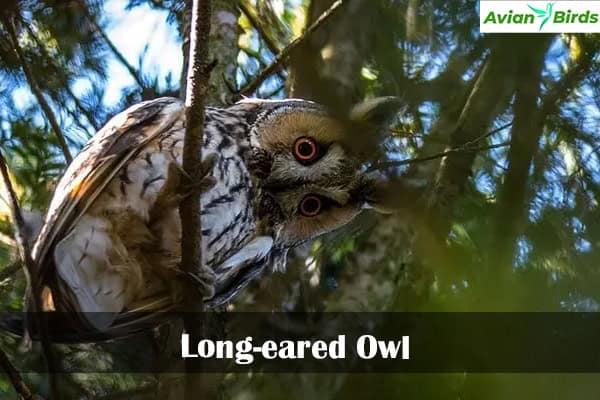
When it comes to hunting, the owl stands still and patiently waits for its prey to come into view. long-eared owl has a diverse diet. Its primary prey consists of small rodents like mice and voles, which are abundant in woodland areas. With its exceptional acute hearing and keen eyesight, this owl is able to locate its prey, such as meadow voles, even in low-light conditions. Once it spots its target, the long-eared owl swoops down silently, using its sharp talons to capture and secure its meal.
Habitat Preferences
Woodlands are the preferred habitat of the long-eared owl. These dense forests provide the perfect environment for the owl to roost and nest. The thick vegetation and tall trees offer ample protection and camouflage, allowing the owl to blend perfectly into its surroundings during daylight hours.
The long-eared owl’s habitat preferences can often overlap with other owl species, making it important to rely on distinct visual and vocal cues to accurately identify this elusive bird.
During the breeding season, long-eared owls take advantage of the dense foliage to build their nests. They often repurpose abandoned nests of other bird species or make use of tree cavities. The female owl will lay a clutch of eggs, usually around 4-6, which are then incubated by both parents. Once the eggs hatch, the parents tirelessly hunt and feed their hungry owlets until they are ready to leave the nest.
Long-Eared Owl Facts
- The long-eared owl is a medium-sized owl species, measuring around 13-16 inches in length with a wingspan of 35-39 inches.
- Unlike some other owl species, the long-eared owl is primarily active at night, relying on its excellent nocturnal vision and hearing to navigate its woodland domain.
- Although the long-eared owl is not considered migratory, some individuals may choose to move southward during harsh winters in search of more abundant prey.
Long-Eared Owl Image
Here is an image of the long-eared owl in its natural habitat: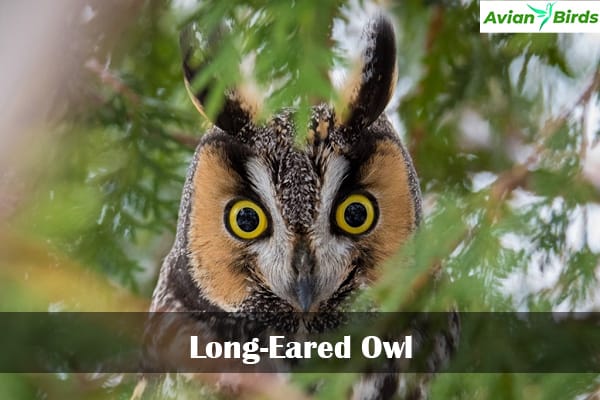
8. Northern Saw-Whet Owl
The northern saw-whet owl, one of the fascinating owls also found year-round in Ohio. is a fascinating member of the owl species that can be found in Ohio. These small owls are known for their adorable appearance and distinctive call. During the nesting season, they make themselves at home in the forests of Ohio, creating unique habitats in nest boxes.
“The northern saw-whet owl is a hidden gem among Ohio’s owl species. Its small size and preference for dense forests make it a challenging bird to spot, but those who are lucky enough to catch a glimpse are rewarded with an unforgettable sight.”
These owls have a particular affinity for nest boxes, which provide them with a safe and secure place to raise their young. By installing these boxes in suitable habitats, we can help support the saw-whet owl population and contribute to their conservation efforts.
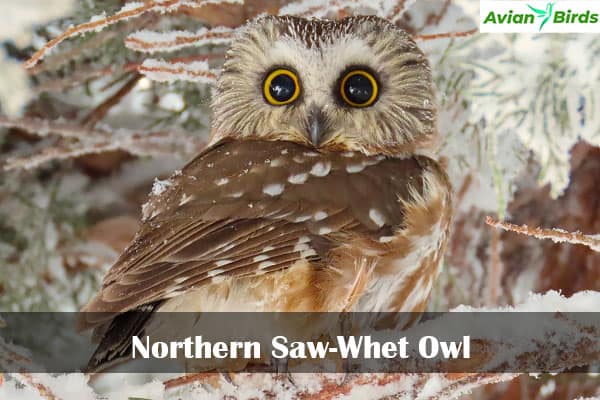
One reason these owls are attracted to nest boxes is for protection from predators. Nest boxes offer a refuge from larger predators, ensuring the safety of the nesting saw-whet owl and its offspring.
Habitat and Nesting Behavior
The northern saw-whet owl prefers to make its home in dense coniferous forests, where it can find ample cover and prey. These forests provide the perfect hunting ground for the saw-whet owl, as they are filled with the small rodents that make up a significant portion of its diet.
- Preferred habitat: Dense coniferous forests
- Diet: Small rodents including mice, voles, and shrews
During the nesting season, the saw-whet owl selects a suitable nest box or natural tree cavity to lay its eggs, ensuring that the habitat supports the avian species. The female owl typically lays a clutch of 4-7 eggs and remains dedicated to incubating them for about a month until they hatch. The male owl assists in providing food for the female during this time.
Once the owlets hatch, they remain in the nest for several weeks, growing rapidly and honing their hunting skills under the watchful eyes of their parents. After a few weeks, they will take their first flights and gradually become independent.
The northern saw-whet owl’s preference for nest boxes makes it an ideal candidate for conservation efforts. By providing suitable habitat in the form of nest boxes, we can contribute to the population growth and preservation of this charming owl species.
Check Our Previous Articles:
Final Thoughts:
Ohio offers a rich habitat for various owl species, making it a captivating destination for bird enthusiasts. With diverse environments like forests, fields, and old barns, spotting these majestic creatures is an adventure in itself. In Ohio, you can find eight distinct owl types, each with its unique characteristics. Venture out at night with a flashlight for an opportunity to observe them in action. It’s a patience-rewarding experience that unveils the beauty and intrigue of these remarkable birds in their natural habitat.
Frequently Asked Questions
Q1. Where can I find owls in Ohio?
Owls in Ohio can be found in a variety of habitats, including woodlands, grasslands, and open areas such as airports and prairies.
Q2. How many species of owls are found in Ohio?
Eight species of owls can be found in Ohio, including the eastern screech-owl, great horned owl, American barn owl, barred owl, snowy owl, short-eared owl, long-eared owl, and northern saw-whet owl.
Q3. What is the habitat of the eastern screech owl?
The eastern screech owl can be found in a variety of habitats, including woodlands, urban areas, and suburban neighbourhoods. It prefers to roost in tree cavities during the day.
Q4. What prey do great horned owls feed on?
Great horned owls feed on a wide variety of prey, including small mammals, birds, reptiles, and sometimes even larger prey such as rabbits and skunks.
Q5. Where do barred owls nest?
Barred owls nest in tree cavities, often in deciduous and coniferous woodlands. They also use abandoned hawk or squirrel nests.

